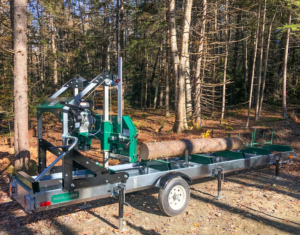
What is a Sawmill? A sawmill can refer to a facility where logs are processed into lumber or a machine that cuts logs into lumber. Modern sawmills are motorized and computerized, producing dimensional lumber efficiently.
What do Sawmills Produce? Sawmills produce softwoods (pine, spruce, cedar, redwood, hemlock) for residential construction and hardwoods (cherry, oak, walnut, beech, maple) for furniture, flooring, and panels. They also offer premade products in various shapes and sizes.
How do Sawmills Operate? The process starts with selecting and limbing trees, transporting logs to the sawmill, debarking, decking, and cutting logs into dimensional lumber. The lumber is then air-dried in a kiln. Sawmills maintain a fast-paced production line to meet high demand.
Types of Sawmills
-
Stationary Sawmills: Fixed structures, often under a roof, historically powered by steam. Modern stationary sawmills are larger, processing large logs up to 15 tons. They are ideal for high production levels in commercial facilities.
- Pros: High production, all-weather operation, great for commercial use.
- Cons: Large, non-transportable, logs must be brought to the mill.
-
Portable Sawmills: Smaller, movable sawmills for personal or professional use. They can be transported to remote areas, useful for DIY projects and land maintenance.
- Types:
- Swing blade sawmills: Movable head on a track, efficient cutting speed.
- Chainsaw mills: Small, portable, for desolate areas, slower cutting speed.
- Band mills: Saw head with band wheels, smallest kerf, easy to operate and transport.
- Pros: Gas or diesel-powered, usable in small areas, easy to transport.
- Cons: Slower cutting speed, rough cuts, weather-dependent.
- Types:
Examples of Popular Sawmills
- Woodland Mills HM126: A popular band sawmill known for its affordability and ease of use. It’s great for small to medium-sized projects and can handle logs up to 26 inches in diameter. Ideal for hobbyists and small businesses.
- Woodland Mills HM130MAX: This model offers a larger cutting capacity, handling logs up to 30 inches in diameter. It’s perfect for those needing a bit more power and versatility.
- Norwood LumberMate LM29: A versatile band sawmill that can be customized with various attachments. It’s ideal for hobbyists and small businesses, offering a balance of affordability and functionality.
- Norwood HD36: Known for its heavy-duty construction and large capacity, this sawmill can handle logs up to 36 inches in diameter. It’s perfect for serious woodworkers and small commercial operations.
- Wood-Mizer LT15: A popular band sawmill known for its affordability and ease of use. It’s great for small to medium-sized projects and can handle logs up to 28 inches in diameter.
- Wood-Mizer LT40: This model is known for its durability and precision, suitable for both small and large projects. It offers a wide range of cutting options and is ideal for professional use.
Stationary vs. Portable Sawmills Stationary sawmills are for high production in commercial facilities, processing large logs efficiently. Portable sawmills are for milling anywhere, ideal for homebuilding and land maintenance, operated by one or two people.
Popular Portable Sawmills Portable sawmills come in various models and prices, from $2,000 to $80,000, catering to different needs and projects.

No responses yet